Yachting World
- Digital Edition


Six solo skippers ready to race 100ft foiling multihulls around the world
- January 4, 2024
Is this the most audacious race ever? Six skippers are getting ready to race 100ft foiling maxi trimarans solo around the world – James Boyd looks forward to the Arkea Ultim Challenge Brest

There are very few ‘firsts’ left in the world of sailing, but one such remaining barrier could be smashed when the Arkea Ultim Challenge Brest sets off from north-west France on 7 January 2024.
Since the Sunday Times Golden Globe in 1968/69 – the ‘impossible feat’ – there have been all manner of non-stop laps of the planet, from fully crewed Jules Verne Trophy and solo records, to races such as the single-handed Vendée Globe , and The Race in 2000 for fully crewed maxi-multihulls. This January sees a new pinnacle-of-pinnacles event: the first solo, non-stop, round the world race in Ultim trimarans. Six brave French skippers on their 100ft multihulls are entered.
The advancement in human endeavour and technology in this cutting edge area of sailing has been extraordinary. Thirty years ago we were in Brest for the first tentative Jules Verne Trophy attempts. Back then no one knew if sailing around the world in under 80 days was even possible: three boats set off and only one made it – Bruno Peyron’s maxi-catamaran Commodore Explorer in 79 days 6 hours.
Since then the record has been reduced by titans such as Peter Blake/Robin Knox-Johnston, Olivier de Kersauson, Loïck Peyron, Franck Cammas and, ultimately, Francis Joyon . In a quarter of a century, the record has halved with Joyon’s 105ft IDEC Sport setting the present benchmark of 40d 23h 30m 30s (at 26.85 knots average) five years ago.
You might assume that a solo around the world would be much slower, but Joyon destroyed this notion. In 2004, when the Jules Verne Trophy record was 63 days, he completed a lap in just under 73 days alone on his 90ft trimaran IDEC (also the first successful solo non-stop circumnavigation by a trimaran). The following year the UK ground to a halt for an afternoon, television dominated by live coverage of Ellen MacArthur’s arrival into Falmouth after she’d taken more than a day off Joyon’s time.

Gabart on his previous Macif Ultime. Photo: Rolex/Carlo Borlenghi
Thomas Coville took the time below 50 days in 2016 with 49d 3h, broken the following year by François Gabart ’s 100ft Macif , establishing the present solo non-stop record: 42d 16h 40m 3s (just 4% slower than Joyon’s fully crewed).
While these times are impressive, they are records set in optimum, carefully selected conditions (for the first two weeks at least), whereas the Arkea Ultim Challenge Brest is a race. The solo sailors will have onshore routers, but their departure day is set, and pace likely dictated by their opponents. It’s a very different test of man and machine.
“It is something new,” says Gitana’s Charles Caudrelier . “The first time racing around the world with these big flying boats. It is a bit like the first Vendée Globe – not quite the same because we know where we are going! But it is a bit of an adventure, and I’m happy about that.”

Armel le Cléac’h in solo mode on Maxi Banque Populaire XI. Photo: Benoît Stichelbaut
The contenders
Surprisingly, skippers at all stages of their careers are competing. Amiable sea-dog Thomas Coville will be 55 when the race sets off. There is almost no major event Coville hasn’t done, from the America’s Cup to winning the Volvo Ocean Race.
Having sailed ORMA 60s, Coville moved into the record breaking business on maxi trimarans and is now on his third, Sodebo having backed him continuously. Of the six skippers Coville is the most experienced racing Ultims single-handed and is laudable for his sheer tenacity – he finally set a solo round the world record on his fifth attempt, after 11 years of trying.
At the other end of the scale, it was a surprise to learn that SVR-Lazartigue will not be raced by François Gabart, the single-handed round the world record holder and the blue trimaran’s initial skipper. Instead, taking over for solo races will be 26-year-old Tom Laperche. An engineer and highly talented sailor, Laperche is a graduate of the classic French offshore racing pathway; and has been involved with SVR-Lazartigue since its launch, racing as Gabart’s co-skipper in the last two Transat Jacques Vabre .
Anthony Marchand, 38, has also newly taken on a campaign, replacing Yves le Blevec on Actual Ultim 3 (ex-Macif) in early 2023. Meanwhile an 11th hour entry is Eric Péron on Adagio , the previous Sodebo Ultim. The boat is something of a ‘Frankenstein’ creation – recycling the 2001 maxi-tri Geronimo with appendages from 2010 America’s Cup winner USA17 – but a fast one.

Thomas Coville, on Sodebo Ultime 3. Photo: Vincent Curutchet/Team Sodebo
“I’ve been preparing for this kind of thing for years now,” said Péron. I haven’t done much preparation on the boat, but for everything else, the boxes are ticked. So, in the short time I’ve got left before the start, I hope to become at one with the machine. What motivates me most of all is the fact that it’s an extreme race, and that’s why I want to take up the challenge. Obviously, I’m not leaving totally confident. But I’m not going to give up.”
In the absence of Gabart, the two favourites are likely to be Armel le Cléac’h on Maxi Banque Populaire XI and Charles Caudrelier on Maxi Edmond de Rothschild (Gitana 17) . Theirs are two of the best funded and oldest teams.
Banque Populaire first sponsored Joyon’s ORMA 60 in 1989 and has campaigned seven trimarans since, including building two Ultims. The team’s first Ultim had a disastrous 2018, before a final crash left it utterly destroyed during the Route du Rhum . Undeterred, the French bank set about building a replacement. Now, alongside SVR-Lazartigue, their two-year-old Maxi Banque Populaire XI is one of the newest Ultims.
SVR-Lazartigue and Banque Populaire XI are essentially VPLP designs (Ultim teams have their own in-house designers, engineers, aero- and hydrodynamists, foil and hydraulics experts), while Maxi Edmond de Rothschild is from Guillaume Verdier – Emirates Team New Zealand’s long term naval architect who has applied much of his Cup experience to the offshore trimaran .

Adagio, the previous Sodebo Ultim. Photo: Yvan Zedda
Impressive statistics
An Ultim’s length can be anything from 24-32m (78ft 8in-105ft) with a maximum beam of 23m (75ft), though in practice all six are trimarans built to, or near to the rule’s maximum. Overall mast height is less than 120% of length of the longest hull, so 38.4m (126ft). Additional rules cover minimum air draught below the beams and float volume. Water ballast, autopilots and automatic anti-capsize systems are permitted, but stored energy (produced by the crew) or the creation of inertial energy and computer or electromechanical assistance for adjusting any of the appendages is forbidden.
As with all things yachting, their quantum performance leap has come since going airborne. Today all six use a similar, complex foil configuration: on each hull is a rudder with an elevator where lift can be adjusted via a flap on its trailing edge. Midships in each float is a giant J-foil, which can be raised, lowered and its rake adjusted. Unique to the Ultims (apart from Adagio) is the daggerboard, which is fitted not only with a trim tab on its trailing edge to prevent leeway, but an elevator.

Maxi Edmond de Rothschild (Gitana 17). Photo: Yann Riou/Gitana
The foils and elevators are adjusted hydraulically in combination to alter, for example, fore and aft trim and ride height, depending upon the point of sail and sea state. Generally the aim is for the platform to have zero heel/pitch. Thanks to the rudder elevators the ride is very stable in pitch (unlike IMOCA 60s ), the foils effectively ‘locking’ the boat to the water.
Just as America’s Cup catamarans that raked their windward rudder elevator to produce downforce (like crew on the rail), so Ultims can produce downforce with their daggerboard elevator. According to Gabart this is vital: racing an Ultim solo is about maximising efficiency so, when a gust hits, the rake on the daggerboard elevator is increased, sucking the trimaran’s main hull down. “If you release the hydraulic main sheet, it takes five minutes to pump it in again,” explains Gabart. “With this, when you are sailing at 40 knots you can add two tonnes [of down force] in one second using minimal energy.”
With their latest substantially larger foils, Ultims can fly in less wind. Originally it required 15-20 knots of wind or 26-27 knots boat speed for Macif to fly, this is now down to 12-14 knots of wind and 21-23 boat speed for SVR-Lazartigue – remarkable considering an Ultim’s 15-17 tonne displacement.
It’s similar on Banque Populaire XI, says Armel le Cléac’h. “We fly in 12-13 knots of wind or 22-23 knots of boat speed. In 15-17 knots of wind we fly upwind at 27-30 knots – that is the big step. Compared to older Ultims like IDEC in the last Route du Rhum, it’s an 8-9 knot improvement.”

Actual Ultim 3, formerly Gabart’s Macif. Photo: Thierry Martinez
Such speeds permit Ultims to become ‘masters of the weather’ – to some extent at least – often travelling so fast that their skippers can choose the weather system they can sail in. Optimum conditions for an Ultim are 15-25 knots (more than this and the sea state becomes too choppy for foiling), so they aim at the sweet spot of weather systems (flat water ahead of a warm front), which they then ride, like a surfer on a wave.
Le Cléac’h says their top speed has been 47 knots, “But that is not an objective. We want to have a good average speed: 40-42 knots for one or two hours is very good. 35-37 knots for 24 hours is very good too.”
Riding a rocketship
So how can skippers handle such a monster-sized boat that is foiling single-handed? Autopilot technology has improved to extraordinary levels of accuracy. According to Gabart, once set up, speed sailing in a straight line is not much different between solo and crewed. “Upwind or downwind VMG you are a little bit better if you are steering and others are trimming. At 65-70° TWA it is no different.”
Naturally manoeuvres are slower alone. Gabart says that going from reefed to full main might take two minutes fully crewed, but at least 10 solo. Some technology helps, like Harken’s latest generation Air 900 winches and pedestal grinders with bespoke gearing for single-person operation.

The newest of the Ultims, SVR-Lazartigue is perhaps the most advanced design. Photo: Guillaume Gatefait
While foils and many sail controls are hydraulic (SVR-Lazartigue has 23 rams), the pedestals are able to drive twin hydraulic pumps – though it requires serious manpower: “80% of the grinding is for the hydraulics,” says Gabart. SVR-Lazartigue will race with just five sails, including main and J0-J3, two permanently rigged on furlers.
Sailing at such high speeds has several effects. With apparent wind factored in, on deck there is constantly storm force, or at best gale force, winds. Human beings cannot operate for long in this and so cockpit protection has drastically increased with some Ultims now fully enclosed.
On the latest Sodebo and SVR-Lazartigue these have moved forward. On the former, the ‘bridge’ is forward of the mast, USS Enterprise-style, while on the latter it is just aft of the mast, with jet fighter-style steering cockpits each side, complete with sliding canopies. The end result is that an Ultim’s crew rarely ventures outside, viewing the world via CCTV.
While foiling reduces hydrodynamic drag, all the teams have been focussed on reducing aero-drag. Crossbeams now have trailing edge fairings made from robust vinyl, while on SVR-Lazartigue, moving their ‘cockpit’ forward has enabled them to have an AC-style ‘deck sweeper’ boom where the deck creates an endplate for the foot of the mainsail (improving efficiency).

Tom Laperche steering, jet fighter-style, on SVR-Lazartigue. Photo: Guillaume Gatefait
To finish first…
For the teams, the principal hurdle of the Arkea Ultim Challenge Brest will be finishing. The major worry on such a long race is reliability. To prevent structural failures Ultims have load cells, the output from which is monitored in real time. Otherwise teams have simply been racing and sea trialling as often as possible in all conditions.
This year’s Transat Jacques Vabre’s heavier conditions were ideal, enabling the double-handed teams to really push the boats harder. While all the Ultims finished, some were in better shape than others, Maxi Edmond de Rothschild suffering rudder and foil issues while Sodebo Ultim’s starboard rudder sheared off after a collision with an underwater object.
“The main problem will be to have all of the boats finishing the race in good shape,” says Caudrelier, who says it will take a new approach from his previous crewed around the world races. “Always you push to the maximum, but this time you can’t do that and we will have to find a good balance between performance and safety for the boat. That is quite an interesting exercise and also managing a boat like this alone for 45 days.”
Éric Péron explains: “On these boats, a small incident can immediately put us out of the race, because nothing can be replaced on our own. The boat is so big that there’s not much we can do to fix it with what we’ve got on board.”
Antoine Gautier, head of the design office at Mer Concept (behind SVR-Lazartigue) adds that their enormously complex boat will be simplified: “We are going to have less systems on board to make it simpler and more reliable. There are some things which won’t make much difference on a round the world race.”

Armel le Cléac’h at Banque Populaire’s mission control/protected pod. Photo: Vincent Curutchet/ Hublot Sailing team
Capsize was once a major concern, but for Ultims today is – apparently – almost a non-issue. The multihulls are simply huge, and their rigs are now stepped almost two thirds of the way back from the bow, to prevent pitchpoling. As Gautier explains: “The boats are definitely safer than any multihulls before. There are no more pitchpoling issues and in terms of heel stability, you almost can’t heel because the leeward foil is pushing up so much. That is why they are able to sail so fast, even short-handed – because the boats are very safe and you don’t feel in danger.”
Nonetheless they do still have inclinometers which can automatically dump hydraulics (eg mainsheet) or mechanically release headsail sheets if heel is excessive.
Of greater concern are elements beyond the skipper’s control: collision. AIS and radar target alarms substantially reduce the chance of an Ultim hitting another vessel, but the threat of a ‘UFO’ (unidentified floating object) remains. As Gautier says: “Collision is the biggest fear for all of us. If you hit something at 30-plus knots it is the end of your race. The boat which is going to win will be the one which has all its appendages at the finish. It is Russian roulette and you can’t do anything about it. This is not a fun part of the sport, but it is the same for any race like this.”
To help prevent such collisions Ultims are all fitted with SEA.AI (previously known as OSCAR) a camera mounted at the masthead that can ‘see’ ahead both in daylight and at night, using infra-red. Images are compared in real time with a giant database to establish whether something ahead represents a collision threat.

Ultims raced each other double-handed in the November 2023 Transat Jacques Vabre – won by Armel le Cléac’h/Sébastien Josse in Banque Populaire XI. Photo: Jean-Marie Liot/Alea
There are other factors too that will come into play: a good deal of luck, undoubtedly, but also the skill, experience and motivation of the skippers. Caudrelier has perhaps the most experience in his boat and over the last three years has won most races, but he has never raced solo around the world. “This is my Vendée Globe” he acknowledges.
By contrast Le Cléac’h has completed three Vendées, on the podium every time. However his recent victory in the Transat Jacques Vabre was his first in an Ultim. For Coville, this might be his last lap? While for Laperche this will be his first big Ultim event and proving himself is a key objective.
What is certain is that this will be the ultimate contest between some of the world’s most talented offshore sailors. How many will make it round? And for those that do, it could be the fastest ever round the world race, so all the action will unfold quickly. Follow at arkeaultimchallengebrest.com
If you enjoyed this….
Yachting World is the world’s leading magazine for bluewater cruisers and offshore sailors. Every month we have inspirational adventures and practical features to help you realise your sailing dreams. Build your knowledge with a subscription delivered to your door. See our latest offers and save at least 30% off the cover price.

A FRESH NEW LOOK FOR THE IDEC SPORT MAXI-TRIMARAN
The IDEC SPORT maxi trimaran, which has been out of the water in the Multiplast yard in Vannes since November, is undergoing her first major update since her launch in 2006. Francis Joyon, who showed the full potential of this VPLP designed boat by smashing the Jules Verne Trophy record (40 days), aims to keep his boat competitive this winter by fitting her with the latest technology in terms of foils. The aim is to ensure she can keep up with the boats recently launched. Foils with spoilers, T-shaped rudders… IDEC SPORT, unanimously recognised and applauded for her extraordinary marine qualities, is now getting ready to take off.
Always ready to offer a great image and aware of the fantastic technological leap forward made by the other boats in the Ultime Class, Francis Joyon is pleased to be able to update his maxi- trimaran, as he looks forward to the battles that lie ahead including the Route du Rhum, which starts from St. Malo on 4th November. “ We won’t really be flying like the more recent boats in the class, ” he stressed, “but thanks to these foiling appendages , we should take off with the central hull just touching the water, and that means we should gain in terms of sheer speed.”
After a lot of discussion and reflection with the boat’s designers, Marc Van Peteghem and Vincent Lauriost-Prévost, Francis decided to fit foils with spoilers and T-shaped rudders to increase the vertical thrust and allow the boat to take off. “ This is the first major change that has been made to this boat developed by Franck Cammas in 2006 and 2007,” added the sailor from Locmariaquer. “ These changes are necessary for us to remain competitive when we come up against the new flying boats , whose full potential still has to be discovered. We should see an increase in the boat’s performance of several percent.”
Good sea handling, safe, reliable, an all rounder, IDEC SPORT is being strengthened without losing anything of what she had before. “ Using the shorter mast means the boat has suffered less and she hasn’t aged as much,” stressed Francis. “ With a brand new mainsail track, and a lot of other small improvements, she will have lost some weight to enable her to perform even better in lighter conditions.”
The Nice Ultimed as a rehearsal
Francis Joyon hopes to get his boat back in the water between 15 th and 30 th March. This will then be followed by sea trials and adjustments. “ All of these fittings are new to us and the crew is going to have to learn how to get the most out of the foils, find the right angles and the best range possible…”
The Nice Ultimed will offer the IDEC SPORT team a long delivery trip, which is an ideal way to get to know everything, before she does battle with the leading boats in the class in what looks like being a tough contest in Nice from 25 th April to 6 th May. “ It is true that this format with crewed racing doesn’t favour us. It is when sailed solo in the Route du Rhum that IDEC SPORT will have the best chance.” Francis is looking forward to this event and has remained faithful to the small valiant crew that won the Jules Verne Trophy. Bernard Stamm and Guénolé Gahinet, who set the round the world record with him, will be back, along with those who took part in The Bridge 2017, Quentin Ponroy and Sébastien Picault.
The RORC Caribbean 600 is the next step for The Famous Project
The famous project, idec sport around europe, the maxi-trimaran idec sport and francis joyon as ambassadors for the arch, francis joyon postpones his attempt against the discovery route record, francis joyon has left la trinité sur mer. destination, spain.
- Go to content
- Deactivate animations
- Activate Animations
- All the latest news
Launch of the new Maxi Trimaran Banque Populaire XI: the Ultim class epitome of audacity!
16 metric tons, 32 meters in length, and 23 meters wide: the Banque Populaire XI is the fruit of 24 months of construction work performed by 150 mostly French and locally based companies.
You have chosen to decline cookies enabling video playback. YouTube allows you to play its videos only if you accept tracing cookies that enable it to deliver targeted ads and content based on your behavior. For further information, please consult YouTube's privacy policy .
By clicking on ‘I accept’, cookies will be placed on your device and you will be able to view our videos. You may withdraw your consent at any time.
The construction of this new 16 metric ton, 32m long, 23m wide, and 37m high ‘Ultim’ class racing trimaran to be skippered by Armel Le Cléac'h required the expertise of 150 companies to ensure its completion in 24 months despite the health crisis!
A synthesis of high technology and fine craftsmanship, this giant of the seas was recently launched on April 27 in Lorient (Brittany). An epitome of audacity, with its S-shaped foils about twice the size of those fitted to previous generations (an application of advanced research in aerodynamics as used in Formula 1 racing cars), Banque Populaire XI is the result of a technological, technical, human and logistical feat that makes it the latest jewel in the crown of the nautical industry and of competitive sailing in general.
Team Banque Populaire drew on the expertise of no fewer than 150 mostly French and locally based companies for the vessel’s design and construction . As a major player in ocean racing both as sponsor and ship-owner, Banque Populaire used this opportunity to support craftsmen, engineers and architects, true to its DNA as a bank working closely with all types of entrepreneur. This initiative also enables the bank to demonstrate its active involvement in promoting the status of all those contributing to the ‘blue economy,’ a sector embracing all economic activities related to the marine environment.
Another challenge now awaits the team with the first trial runs for Armel Le Cléac'h and his co-skipper Kevin Escoffier in preparation for the start of the Transat Jacques Vabre Normandy Le Havre race in November later this year. THE BANQUE POPULAIRE XI MAXI TRIMARAN IN FIGURES
- 32 meters in length, 23 meters wide, weighing 16 metric tons
- 24 months in the making4,500 hours of preparatory work (design, architecture, plan, simulation carried out by the VPLP firm of naval architects)
- 300 production blueprints
- 150 companies involved
- 150,000 hours of work (including more than 100,000 hours for the CDK Technologies shipbuilding facility alone)
@PHOTO / Vincent Curutchet

Published on January 15th, 2024 | by Editor
Brazilian pit-stop in maxi trimaran race
Published on January 15th, 2024 by Editor -->
(January 15, 2024; Day 9) – While the leading duo of Tom Laperche (SVR Lazartigue) and Charles Caudrelier (Maxi Edmond de Rothschild) are still less than 50 miles apart in the ARKEA ULTIM CHALLENGE-Brest, making around 34-35.5 knots sailing SSE of Salvador de Bahia, Brazil, the first pit-stop for the six-boat Ultim fleet has occurred.
In this solo, non-stop race around the world in the 32m Ultim Class, Armel Le Cléac’h (Maxi Banque Populaire XI) arrived today in the port of Recife in Recife just before 0740hrs UTC. A team from Banque Populaire was waiting for her so that they could begin repairs as soon as the boat was docked.
When his big gennaker came loose at the tack and tore off the pulpit during gales several nights earlier, his team was unanimous the skipper should not go into the ‘big south’ with no pulpit on the main hull.
He is expected to time his departure from the Brazilian port at the required 24 hours minimum stipulated by the rules for a skipper who accepts help for a pitstop.

“Continuing the race without the pulpit which keeps me safe during maneuvers would be impossible,” Le Cléac’h said. Maxi Banque Populaire XI also has an issue with the hydraulics on the starboard foil which would not go right down and the team was standing by to repair.
“We will be back to sea tomorrow morning,” reiterated the skipper. “So many things can still happen, the race is far from over.”
According to the SIs which stipulate the minimum of 24 hours, the Maxi Banque Populaire XI will not be able to leave before 07:38 a.m. UTC tomorrow morning.
For Laperche and Caudrelier, they are working their way around the Saint Helena High in the South Atlantic, and have yet to depart from the Brazilian coast line. However, they are both looking to have a good timing to hook into a depression, probably in two days, with the low promising downwind conditions with the winds averaging 25 to 35 knots which will take them to the tip of South Africa by December 19
More than 400 miles behind Thomas Coville (Sodebo Ultim 3) is now third. Having been racing side by side with Armel Le Cléac’h for a long time, Coville is now on his own as he transits the western side of the Saint Helena anticyclone. But what is concerning for the eight times round the world circumnavigator Coville is that he won’t make it on to the same depression as the first two.
Observes Race Director Guillaume Rottee, “The door will close, the anticyclone will expand again, which will not be easy.”
Anthony Marchand is the fifth skipper to pass the Equator. The skipper of Actual Ultim 3 crossed it at 1057hrs UTC after 7 days, 22 hours and 27 minutes at sea, or 1 day, 16 hours and 14 minutes after Tom Laperche. He had a more complicated battle with the doldrums where he had slightly less wind than expected.
“It was a little slower and harder than for the leaders who didn’t stop,” explains Rottee. “But from now on Marchand is heading towards the Brazilian coast. He probably won’t get past Recife before Armel comes back out but it’s always better for morale to have a boat close to you.”
In sixth, Éric Péron is more than 1,800 miles from the race lead after having to be patient to maneuver between the Cape Verde cetacean exclusion zone and a light wind area which had slowed his progress. But that is behind him and the skipper of ULTIM ADAGIO gybed onto starboard to head west and head down to the Doldrums.
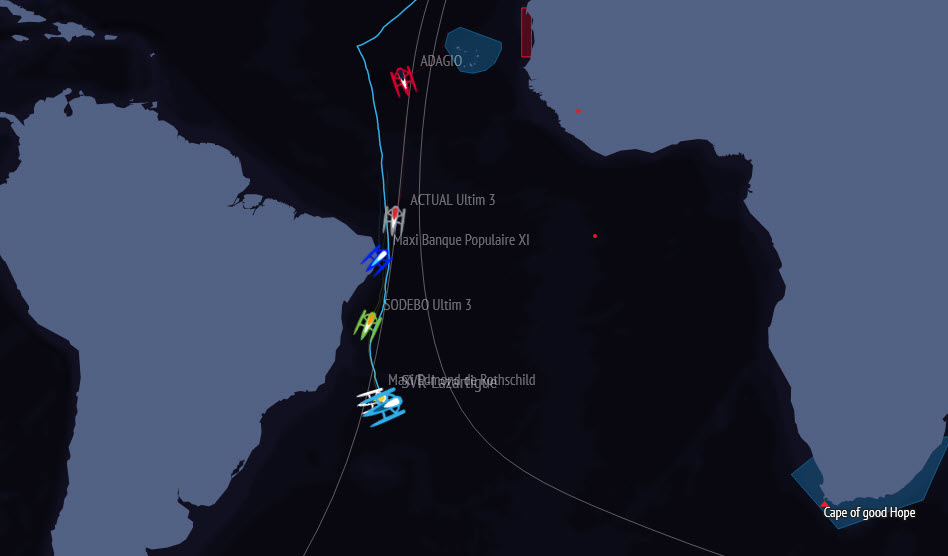
Details: https://arkeaultimchallengebrest.com/en
The Ultim Class trimarans have a maximum length of 32 meters and a maximum width of 23 meters.
The solo speed record around the world was set in 2017 by François Gabart (FRA) on the 30m Macif trimaran in a time of 42d 14h 40m 15s for an average speed of 21.08 knots. This yacht has been rebranded and will be raced by Marchand.
Entrants: • Charles Caudrelier (FRA), Maxi Edmond de Rothschild (2017 Verdier 32/23) • Thomas Coville (FRA), Sodebo Ultim 3 (2019 VPLP/others 32/23) • Tom Laperche (FRA), Trimaran SVR-Lazartigue (2021 VPLP 32/23) • Armel Le Cléac’h (FRA), Maxi Banque Populaire XI (2021 VPLP 32/23) • Anthony Marchand (FRA), Actual Ultim 3 (2015 VPLP 30/22) • Éric Péron (FRA), Trimaran Adagio (2014 VPLP 31/21)* * Only entrant without foiling appendages
Five rules from the Sailing Instructions: • The start line is kept open for 168 hours and the finish line is closed after an elapsed time of 100 days after the start time, that is to say 16th April 2024.
• The skippers can communicate and exchange with their teams on shore, so they have the freedom to get weather information and be routed by their team on shore and get technical help and advice to help with technical problems.
• The solo skippers can stop but there are two distinct operations. A technical stop is unassisted and requires the sailor to drop anchor, take a mooring, or tie up alongside an anchored or moored boat with no external help. There is no time penalty for a technical stop. But for a technical stopover (escale technique) where one or more crew or technical team come on board to help, there is a mandatory 24 hours minimum. This does not apply to the start port of Brest where all means are authorized to reach or leave the port within a radius of 50 miles.
• For the first time in ocean racing, zones where there are known to be a high concentration of whales and sea mammals are determined. Establishing these zones should both protect the marine wildlife and reduce the chance of a collision. These zones are around the Azores, the Canaries, south of South Africa, the Kerguelens, and parts of the Antarctic.
• There are ice exclusion zones to protect the skippers and their boats.

Tags: ARKEA ULTIM CHALLENGE – Brest , Ultim Class
Related Posts
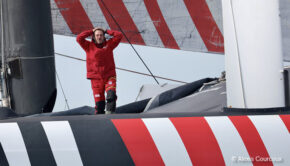
Ultim Challenge done with final finish →
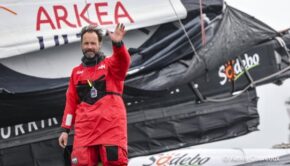
Coville finishes second in Arkea Ultim Challenge →

Caudrelier wins Arkea Ultim Challenge →
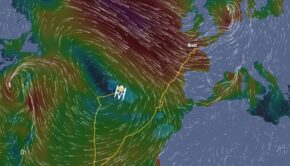
Evil welcome for Arkea Ultim Challenge →
© 2024 Scuttlebutt Sailing News. Inbox Communications, Inc. All Rights Reserved. made by VSSL Agency .
- Privacy Statement
- Advertise With Us
Sails of Change suffers damage
On course in an attempt to set a new North Atlantic record, Sails of Change collided with an unidentified floating […]
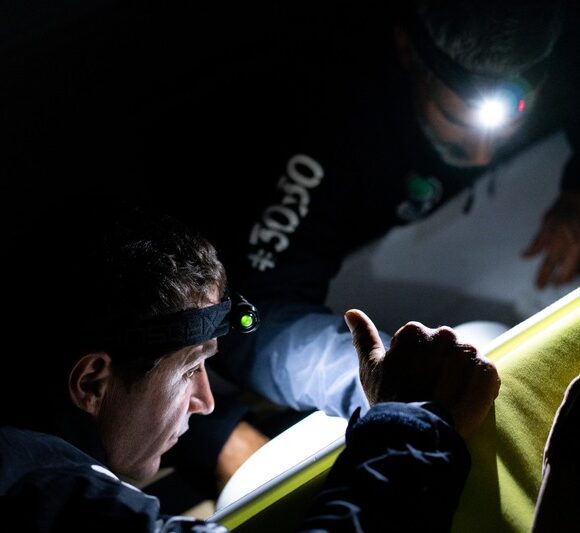
23.07.28 Maxi-trimaran
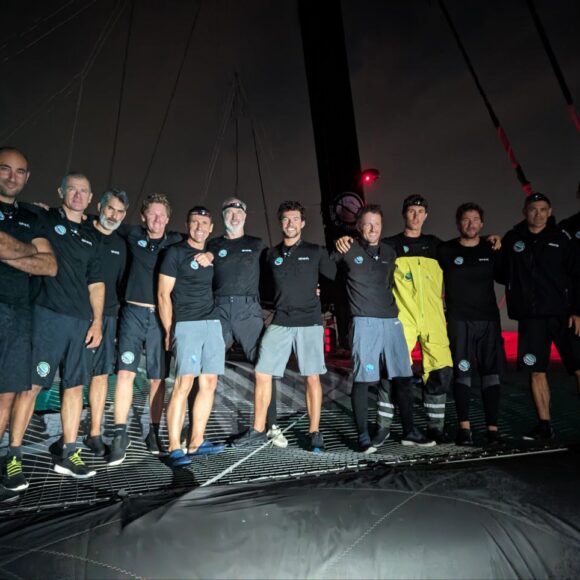
23.07.27 Maxi-trimaran
Sails of Change takes on the North Atlantic record
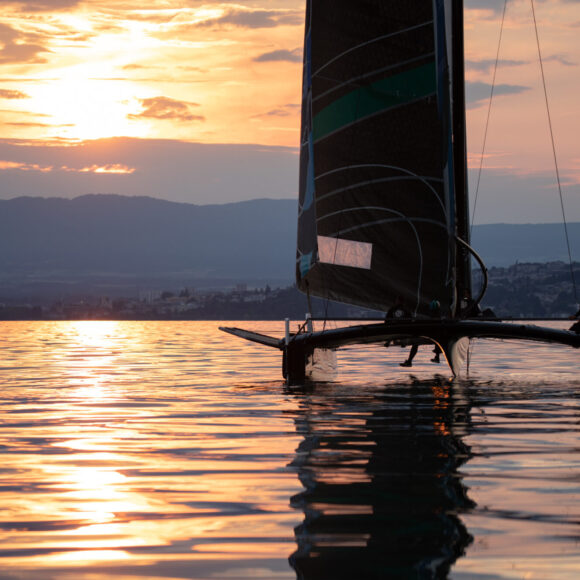
23.06.17 TF 35
In celebration of a slower pace : a look back at the Bol d’Or Mirabaud 2023
This month’s media.
Media : Video Duration : 00:00
Behind the scenes at the Bol d'Or Mirabaud 2023 !

Weight: 1200kg
Number of crew aboard: 6
Maximum speed: 68 KM/HR


Maxi-trimaran
Weight: 21 tonnes
Number of crew aboard: 11
Maximum speed: 90 km/h
Notre équipe
Maxi-trimaran.
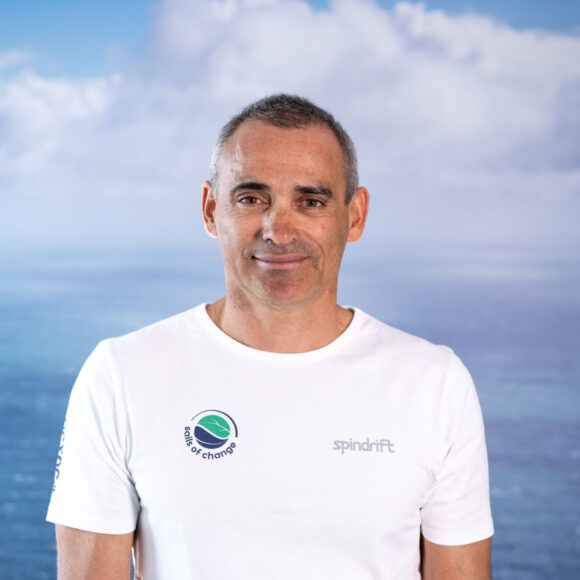
Yann Guichard
President, co-founder.
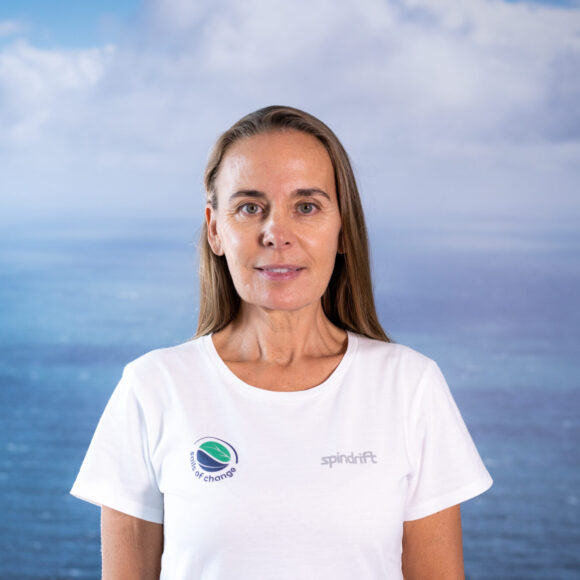
Dona Bertarelli
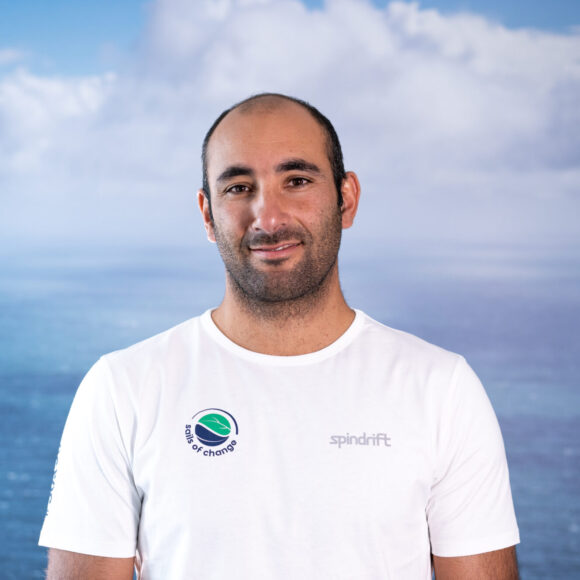
Benjamin Schwartz
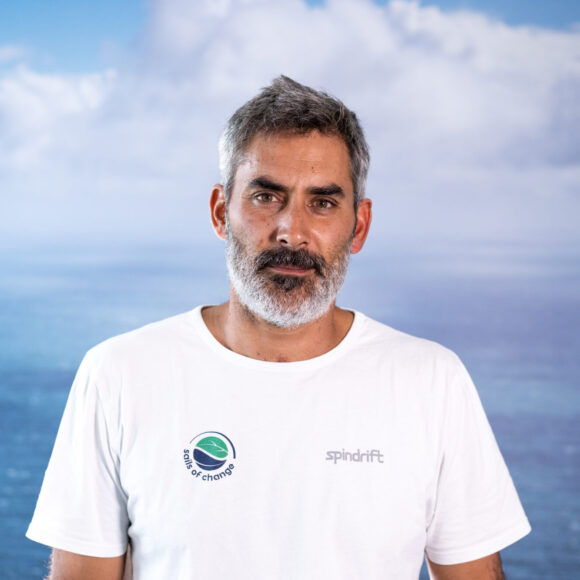
Jacques Guichard
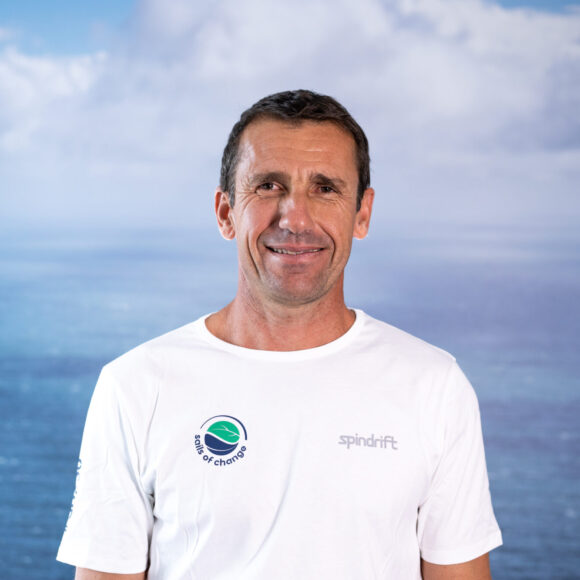
Xavier Revil
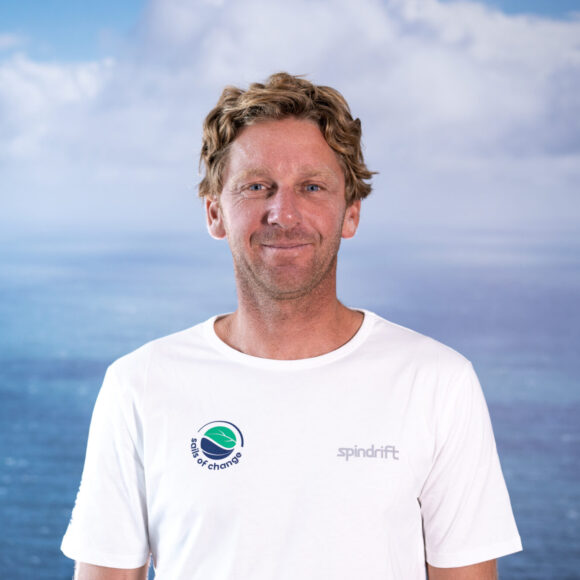
Grégory Gendron
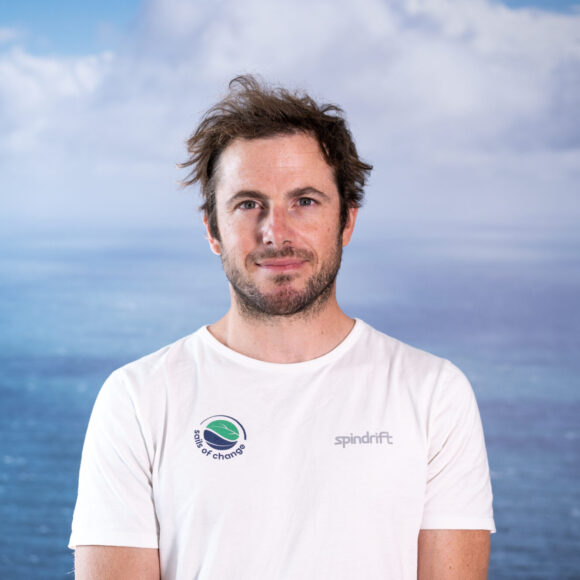
Julien Villion
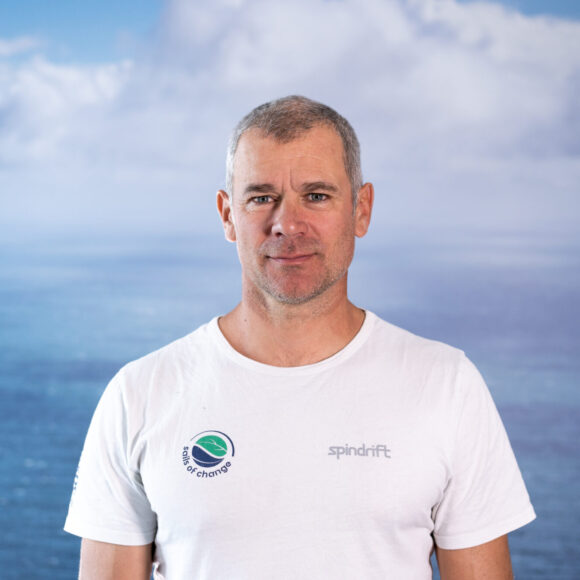
Thierry Chabagny
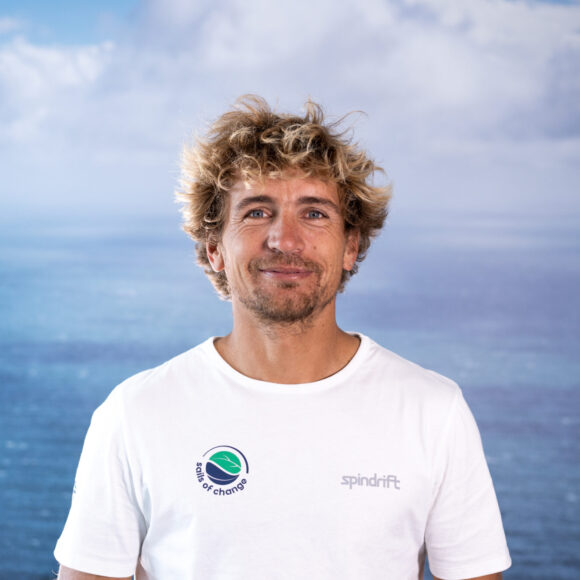
Pierre Leboucher
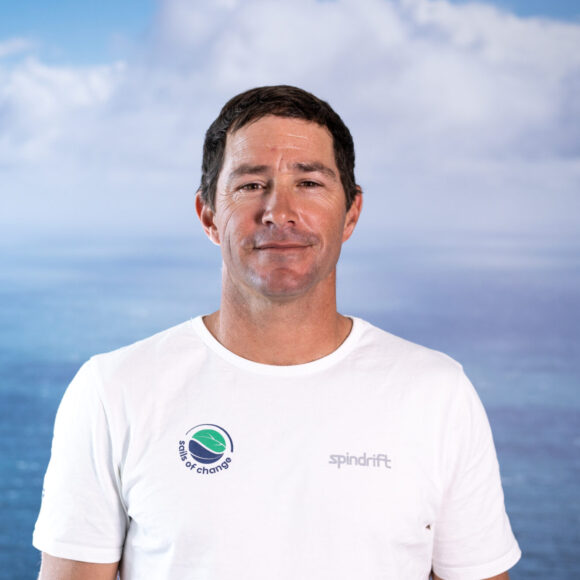
Clément Giraud
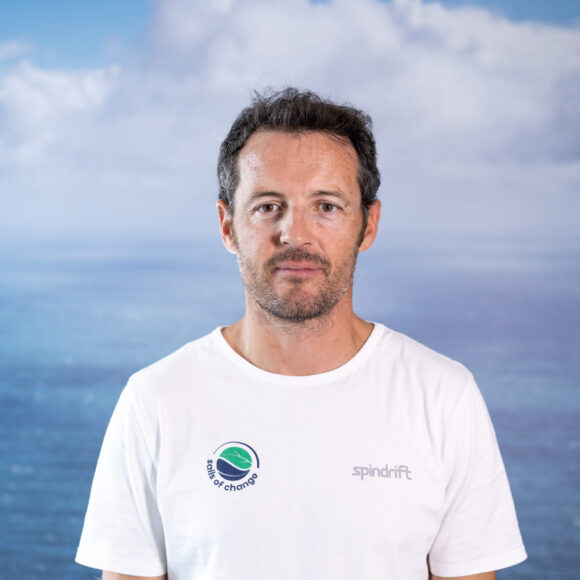
Christopher Pratt
Best performance

Sails of Change
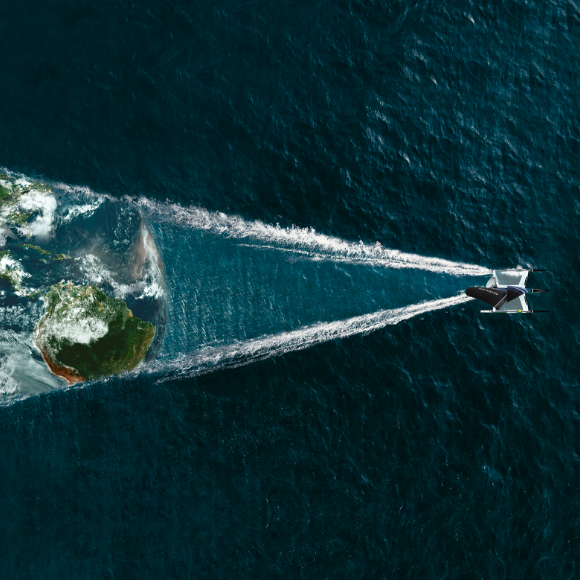
Sharing our values
True to its name which conjures up images of spray blown from the crests of waves by the breeze, the open ocean and human adventures, the Spindrift team is writing a new chapter in its history. Targeting performance naturally remains central to this ambition, guided by the commitment displayed by its owners Dona Bertarelli and Yann Guichard.
Born from their shared passion for the ocean, the Spindrift epic continues today for its preservation.
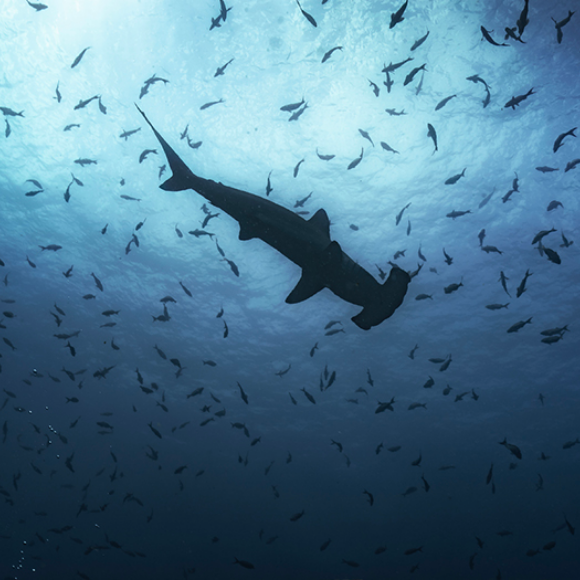
A unique platform
Our survival depends on nature. Indeed, humanity’s fate is inextricably linked to the balance of the natural world, and the health of the oceans in particular, which cover two-thirds of our planet.
Inspired by the beauty of our planet and its biodiversity, Sails of Change is a platform which shines a spotlight on how important it is to restore a lasting balance between humanity and its environment.
Our partners
Environnement.

Our message


IMAGES
VIDEO
COMMENTS
Six skippers are getting ready to race 100ft foiling maxi trimarans solo around the world - James Boyd looks forward to the Arkea Ultim Challenge Brest. There are very few 'firsts' left in ...
The former Groupama 3 and Banque Populaire VII, the IDEC SPORT maxi-trimaran has had an exceptional list of successes. Winner of the Jules Verne Trophy in 2010 and 2012, and again in 2017, the boat also won the last three editions of the Route du Rhum - and many other events. Thirteen years after she was first launched, this strong all-round ...
Watch this spectacular footage of the 130ft maxi trimaran Spindrift 2 as she sails from France on her fourth attempt to break the non-stop round the world re...
The Maxi-trimaran Idec Sport, a legendary boat. To succeed in their gamble, the sailors will be embarking on the fastest maxi-trimaran in the world: Idec Sport, holder of the Jules Verne Trophy record since 2017 in 40 days 23 h 30 min and 30 sec.
In 2019, the maxi-trimaran bagged the new record for the Ushant - equator section of the course in a time of 4 days 19 hours and 57 minutes, on her third attempt at the Jules Verne Trophy. Between June 2020 and March 2021, countless improvements were made to the maxi-trimaran at the Multiplast yard with the aim of maximising her future ...
The maxi trimaran has also sailed on multiple occasions. "There are still a few adjustments to be made, but the boat is ready," said Yann Guichard. "I can feel the team is eager to go." Once standby begins, the maxi trimaran, based at La Trinité-sur-Mer, will be ready to set off for Brest at the first favourable weather window.
Adam Cort. Jun 21, 2022. The Ultim class is set to race round the world in 2023. Photo courtesy of Yvan Zedda/OC Sport Pen Duik. For years now, maxi-trimarans, both solo-sailed and fully crewed, have been racing the clock on their own around the world in an effort to set ever faster records for the world's fastest circumnavigation under sail.
In the meantime, the maxi-trimaran, the biggest racing multihull in the world, had to integrate Sails of Change's colors, while carrying the #30×30 campaign, a global call to action aiming to protect at least 30% of the ocean and land by 2030. We decided to work with French artist Jean-Baptiste Epron, whose job is to imagine, draw and design ...
The IDEC SPORT maxi trimaran, which has been out of the water in the Multiplast yard in Vannes since November, is undergoing her first major update since her launch in 2006. Francis Joyon, who showed the full potential of this VPLP designed boat by smashing the Jules Verne Trophy record (40 days), aims to keep his boat competitive this winter ...
The construction of this new 16 metric ton, 32m long, 23m wide, and 37m high 'Ultim' class racing trimaran to be skippered by Armel Le Cléac'h required the expertise of 150 companies to ensure its completion in 24 months despite the health crisis!. A synthesis of high technology and fine craftsmanship, this giant of the seas was recently launched on April 27 in Lorient (Brittany).
France / La Trinité-sur-mer - Dona Bertarelli and Yann Guichard are once more set to take on the Jules Verne Trophy, held since 2017 by Francis Joyon and his...
Spindrift Racing. Maxi-trimaran Sails Of Change will be on standby to attempt at the Jules Verne trophy. In the 11 years since Spindrift Racing made its debut, the pro sailing team has made a big splash, and the upcoming season is expected to be no different. Spindrift co-owners Dona Bertarelli and Yann Guichard recently unveiled their plans ...
Brazilian pit-stop in maxi trimaran race. Published on January 15th, 2024 (January 15, 2024; Day 9) - While the leading duo of Tom Laperche (SVR Lazartigue) and Charles Caudrelier (Maxi Edmond ...
The first maxi-trimaran designed to fly in the open water, the Maxi Edmond de Rothschild will always be the first boat of this kind to have rounded the Horn in race format. Present in Tierra del Fuego, Yann Riou and Marin Le Roux were able to immortalise this unique and historic moment. These images alone from the end of the world evoke the ...
The Maxi-trimaran Sails of Change, on stand-by since October 24, 2022, for a new attempt on the round the world sailing race, the Jules Verne Trophy, arrived in Brest today. The delivery trip from La Trinité-sur-Mer went smoothly in a moderate southerly wind. Now based near Ushant, the boat and crew are waiting for a favourable weather window ...
Видео про город Краснодар, снятое с высоты. 4K (UHD). Музыка:1. System F feat. Armin van Buuren - Exhale (Armin van Buuren Remix)2. Faruk Sabanci ...
Football club Krasnodar © 2008—2023. When using the site materials reference is obligatory RSS news FC Krasnodar Our Socials: Web developer: Quartex Group
The maxi-trimaran Sails of Change has returned to the liquid element, to the sea and the waves. After a two-month summer refit completed right on schedule, the relaunch itself was a victory for the Spindrift teams. "They did an excellent job", exclaimed Yann Guichard. In addition to checking all the on-board systems (mechanical, hydraulic ...
Прыжки с парашютом, прыжки с веревкой, полёты на самолетах, полёты на воздушном шаре, полеты на параплане. Оригинальные подарочные сертификаты SkyKrasnodar.
On November 1 st, 2021, Dona Bertarelli, Yann Guichard and their team began the standby for a fourth attempt at the Jules Verne Trophy around-the-world sailing record.Since this date, there has not been a suitable weather window for the crew of the maxi-trimaran Sails of Change to set sail with a realistic chance of beating the record. Today, Dona Bertarelli and Yann Guichard announce the end ...
5. 2-8. 4. * G - played games, W - won, D - drawn, L - lost, GF-GA - goals for and goals against, P - points. In case 2 (two) teams are equal on points, their rankings in the standings are determined in the following sequence: 1) higher number of wins in all matches; 2) results of the matches played among teams in question (number ...
23.07.28 Maxi-trimaran Sails of Change suffers damage. On course in an attempt to set a new North Atlantic record, Sails of Change collided with an unidentified floating […] Read more. News. 23.07.28 Maxi-trimaran. Sails of Change suffers damage. 23.07.27 Maxi-trimaran.